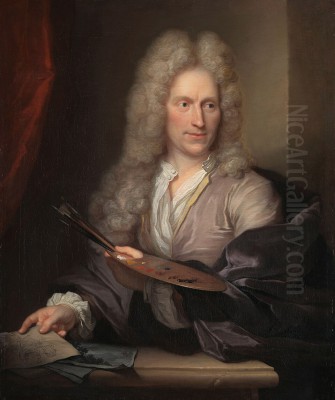
Jan van Huysum stands as a towering figure in the history of Dutch art, particularly renowned for his exquisite still life paintings of flowers and fruit. Active during the late Dutch Golden Age and the early 18th century, he brought the genre to an unprecedented level of refinement, detail, and luminous beauty. His technical virtuosity and unique aesthetic earned him immense fame during his lifetime, attracting patrons from the highest echelons of European society. Often hailed as the "phoenix of flower painters," Van Huysum's legacy endures, his works celebrated for their breathtaking realism and elegant compositions.
Early Life and Artistic Formation in Amsterdam
Jan van Huysum was born in Amsterdam on April 15, 1682, into a family deeply immersed in the world of art. His father, Justus van Huysum the Elder (c. 1659–1716), was a respected painter in his own right, known for his versatility in depicting landscapes, seascapes, battle scenes, portraits, and, significantly, flower pieces. It was under his father's tutelage that Jan received his initial artistic training, absorbing the fundamental techniques of painting within the bustling artistic environment of Amsterdam.
The Amsterdam of Van Huysum's youth was still a major European cultural and economic center, although the peak of the Dutch Golden Age was arguably passing. The market for luxury goods, including finely painted still lifes, remained strong among the wealthy merchant class and increasingly among international collectors. Jan grew up surrounded by art; besides his father, his brothers Justus the Younger, Jacob, and Michiel also pursued careers as painters, often working in similar genres, contributing to a dynamic, if sometimes competitive, family artistic enterprise.
While his father provided the foundational skills, Jan van Huysum quickly developed his own distinct approach. He studied the works of earlier masters of Dutch still life, drawing inspiration from the rich tradition that preceded him. Figures like Jan Davidsz. de Heem (1606–1684), known for his opulent and complex compositions, certainly provided a high standard and perhaps a point of departure for Van Huysum's own explorations in the genre. However, Van Huysum would soon surpass his predecessors and contemporaries in specific aspects of technique and style.
The Development of a Unique Style
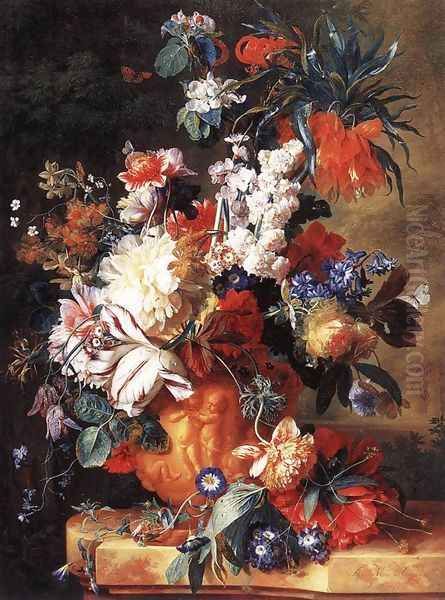
Jan van Huysum's artistic signature lies in his extraordinary ability to render flowers and fruit with astonishing precision and lifelike detail. His works are characterized by meticulous brushwork, capturing the delicate textures of petals, the fuzzy skin of peaches, the translucence of grapes, and the minute details of leaves and stems. He often included insects – butterflies, flies, ants, and beetles – crawling or resting on the arrangements, enhancing the trompe l'oeil (trick of the eye) effect and adding a layer of dynamic realism. Dewdrops clinging to petals or leaves were another favoured motif, showcasing his mastery in depicting light and reflection.
A significant innovation associated with Van Huysum was his move towards lighter, airier backgrounds, particularly in his mature period from around 1720 onwards. While earlier Dutch still lifes, including some of his own initial works, often featured dark, dramatic settings in the tradition of Caravaggio's influence, Van Huysum increasingly favoured luminous, pale backgrounds. This shift allowed the vibrant colours of the flowers and fruits to stand out more brilliantly and contributed to a sense of elegance and grace that resonated with emerging Rococo sensibilities.
His compositions became increasingly complex and sophisticated. He arranged flowers in elaborate bouquets, often overflowing from classical urns or simple glass vases placed on stone ledges. These arrangements were not strictly botanical records; Van Huysum famously combined flowers that bloomed in different seasons into a single composition. This practice created idealized, fantastical bouquets impossible in nature, showcasing his artistic imagination alongside his observational skills. It required him to work from individual studies made over long periods, waiting for specific flowers to bloom.
The overall effect of Van Huysum's style is one of refined elegance, technical brilliance, and an intense appreciation for the beauty of the natural world, albeit enhanced and perfected through art. His paintings blend the meticulous observation characteristic of the Dutch tradition with a lighter palette and more decorative sensibility that looked towards 18th-century tastes, particularly those influenced by French art.
Masterpieces and Signature Works
Among Jan van Huysum's most celebrated works are his elaborate floral compositions. A prime example is Bouquet of Flowers in an Urn (c. 1724), now housed in the Los Angeles County Museum of Art. This painting exemplifies his mature style, featuring a dazzling array of over thirty species of flowers and fruits, meticulously rendered against a light background. The sheer variety, including tulips, roses, poppies, carnations, hollyhocks, and morning glories, combined with fruits like grapes and peaches, and the ubiquitous insects, creates a scene of incredible richness and detail. The work likely took years to complete, reflecting his method of painting from life as each element came into season.
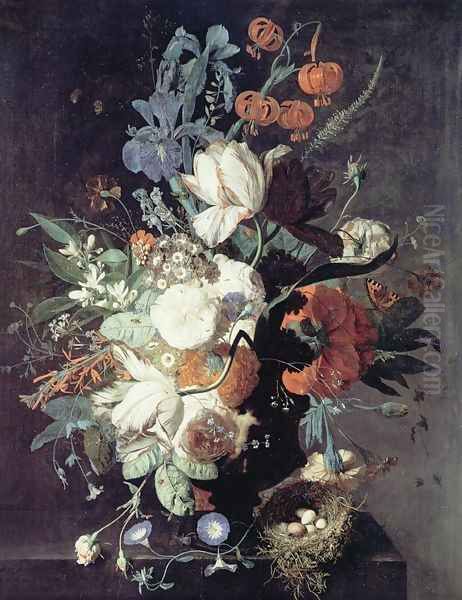
Another key work, often simply titled Vase of Flowers (examples exist in several collections, including the National Gallery, London, and the Wallace Collection), showcases his skill in depicting transparency and light. When painting flowers in glass vases, he masterfully captured the way light refracts through the water and glass, revealing the submerged stems within. These works highlight his sensitivity to subtle light effects and contribute significantly to the overall realism and vibrancy of the scene.
While best known for his flower and fruit pieces, Van Huysum also painted landscapes, often in an idealized, Arcadian style reminiscent of Italianate Dutch painters like Jan Both or Nicolaes Berchem. Works such as Italian Landscape with Fruits demonstrate his capability in this genre, though they remain secondary to his fame as a still life painter. These landscapes often incorporate the same meticulous attention to detail found in his floral works, particularly in the rendering of foliage and atmospheric effects.
These representative works underscore Van Huysum's dedication to achieving the highest degree of finish and realism, combined with an artistic license that allowed him to create compositions of unparalleled beauty and complexity. They cemented his reputation as the preeminent flower painter of his time.
Technique, Secrecy, and Working Methods
Jan van Huysum's technical prowess was legendary, and he guarded his methods closely. He achieved his luminous colours and smooth finish through the careful application of thin layers of oil paint, known as glazes. This technique allowed for subtle gradations of tone and intense, jewel-like colours. His brushwork was exceptionally fine, enabling him to render the most minute details, from the veins on a leaf to the hairs on a caterpillar.
His commitment to realism extended to intense observation. He drew numerous studies from life, capturing the specific characteristics of each flower, fruit, and insect. As mentioned, his practice of combining flowers from different seasons necessitated working on paintings over extended periods, sometimes years. He would wait patiently for a particular bloom to become available to add it to his composition, ensuring botanical accuracy for each individual element, even if the overall bouquet was an idealized construct.
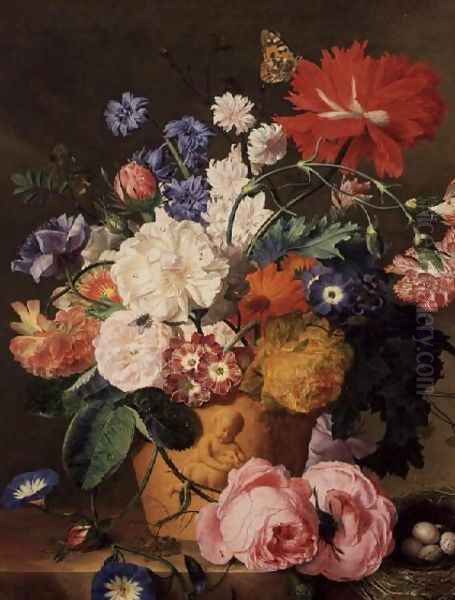
Van Huysum was notoriously secretive about his studio practices. Contemporary accounts relate that he often worked in seclusion, forbidding visitors, even family members, from entering his workspace while he painted. This secrecy was likely driven by a desire to protect his unique techniques from competitors, particularly his methods for achieving certain colours or effects. It may also have reflected a meticulous, perhaps obsessive, personality focused intensely on his craft. He took on very few pupils during his career, with Margareta Haverman being a notable, though short-lived, exception. This reluctance to teach further contributed to the mystique surrounding his methods.
This combination of painstaking technique, prolonged working periods, and intense secrecy contributed to the perception of Van Huysum as an artist singularly dedicated to achieving perfection in his chosen genre.
Patronage, Reputation, and Market Success
During his lifetime, Jan van Huysum achieved extraordinary fame and commercial success. His paintings commanded exceptionally high prices, reportedly fetching sums between 1,200 and 4,600 guilders – amounts that could exceed prices paid for works by masters like Rembrandt van Rijn in earlier decades. This reflects both the quality of his work and the high demand for luxury still lifes among the elite.
His patrons included wealthy Dutch merchants, but his fame quickly spread internationally. He received commissions and his works were eagerly collected by aristocrats, diplomats, and royalty across Europe. Princes, electors in Germany, dukes, counts, and even figures like King Louis XV of France (through court painters like Jean-Baptiste Monnoyer and Jean-Baptiste Van Loo who recognized his talent), Sir Robert Walpole in England, and members of other royal courts sought out his paintings. The presence of his works in prestigious collections like that of King Charles III of the United Kingdom today attests to this long history of elite patronage.
His reputation as the "phoenix of flower painters" or "king of flower painters" was well-established during his lifetime. Critics and connoisseurs lauded his unparalleled ability to capture the beauty of nature with such fidelity and elegance. His success was such that it inevitably spawned imitators, though few could match the refinement and brilliance of his technique. His dominance in the field of floral still life was virtually unchallenged during the first half of the 18th century.
While immensely popular, some later critics, particularly in the 19th century when artistic tastes shifted, occasionally found his work too perfect, perhaps lacking the deeper emotional resonance or moral weight found in earlier Dutch art. However, within the context of 18th-century aesthetics, which valued elegance, refinement, and technical skill, Van Huysum's art represented a pinnacle of achievement.
Artistic Context and Contemporaries
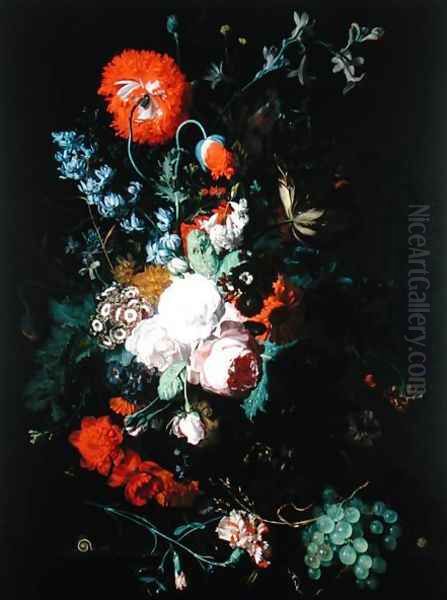
Jan van Huysum operated within a rich tradition of Dutch still life painting, but his work also reflects the changing artistic currents of the early 18th century. He built upon the legacy of 17th-century masters like Jan Davidsz. de Heem, Willem Kalf, and Abraham Mignon, who had established the genre of the opulent still life (pronkstilleven). He also looked back to earlier traditions of detailed botanical illustration seen in the works of artists like Joris Hoefnagel, Jacques de Gheyn II, and Roelandt Savery.
Among his direct contemporaries, the most significant figure in flower painting was Rachel Ruysch (1664–1750). Ruysch, also highly successful and internationally renowned, often favoured darker backgrounds, especially earlier in her career, creating a different mood compared to Van Huysum's later, lighter compositions. While both artists achieved remarkable realism and intricate detail, their styles offer distinct variations within the genre. There is no record of direct collaboration or interaction, reflecting perhaps Van Huysum's secretive nature, but they were certainly the leading exponents of flower painting in the Netherlands during their overlapping careers.
The influence of French Rococo aesthetics, characterized by lightness, elegance, and decorative curves, can be discerned in Van Huysum's compositions, particularly in the graceful arrangement of flowers and the preference for brighter palettes. While rooted in Dutch tradition, his work appealed strongly to international tastes shaped partly by French fashion. Artists like Jean-Baptiste Monnoyer, a French flower painter who worked for Louis XIV, represented a parallel development in floral painting that shared some affinities with Van Huysum's elegance.
Within his own family, his brothers Jacob van Huysum (who later worked in England), Justus van Huysum II, and Michiel van Huysum also painted still lifes, sometimes leading to attribution challenges, although Jan's superior skill generally distinguishes his work. His father, Justus van Huysum the Elder, remained an important foundational figure. The Van Huysum workshop, therefore, was a significant force in Amsterdam's art scene.
Legacy and Enduring Influence
Jan van Huysum died in Amsterdam on February 8, 1749, leaving behind a legacy as one of the most accomplished still life painters in Western art history. His influence extended well beyond his lifetime. His meticulous technique and elegant compositions set a standard for flower painting throughout the 18th century and beyond.
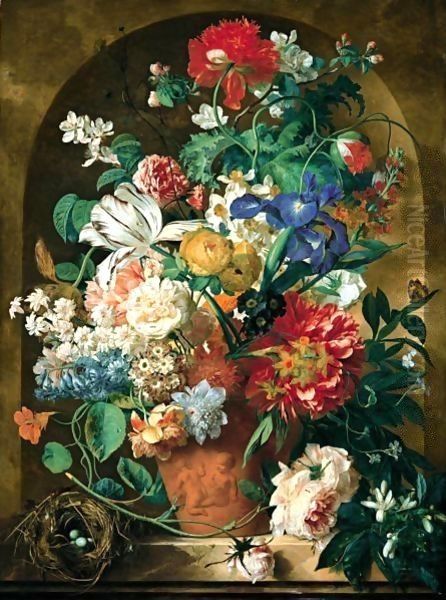
His most direct followers included his own pupils (though few) and family members, such as his son Jan van Huysum II (though less is known about him) and potentially influencing the style of artists like Jan van Os (1744–1808), who married Van Huysum's granddaughter and continued the tradition of detailed fruit and flower painting into the later 18th century. Gerard van Spaendonck (1746–1822), a Dutch painter who became highly successful in Paris, clearly absorbed lessons from Van Huysum's work in his own celebrated floral pieces. Even 19th-century painters like the Austrian Ferdinand Georg Waldmüller looked back to the Dutch Golden Age masters, including Van Huysum, for inspiration in detailed naturalism.
Van Huysum's works have remained highly prized by collectors and museums. Major institutions worldwide, including the Rijksmuseum in Amsterdam, the Mauritshuis in The Hague, the Louvre in Paris, the National Gallery in London, the British Museum, the Gemäldegalerie in Berlin, the Alte Pinakothek in Munich, and numerous others across Europe and North America, hold significant examples of his paintings. His art continues to be studied for its technical brilliance and as a reflection of 18th-century taste.
He represents the culmination of the Dutch tradition of flower painting, pushing its technical boundaries to their limits while adapting it to the refined aesthetics of his time. While the genre itself would evolve, Van Huysum's achievement remains a benchmark against which later still life painters are often measured.
Concluding Thoughts: The Phoenix Painter
Jan van Huysum's career was marked by extraordinary artistic skill, immense popularity, and a dedication to his craft that bordered on the obsessive. His ability to render the natural world with breathtaking fidelity, combined with his talent for creating harmonious and elegant compositions, secured his place as the preeminent flower painter of the 18th century. The nickname "phoenix" aptly suggests his unique status and the almost magical quality of his art.
His move towards lighter backgrounds, his combination of seasonal blooms into idealized arrangements, and his unparalleled mastery of detail distinguish his work. While his legendary secrecy adds an element of mystery to his persona, his paintings speak volumes about his artistic vision. They celebrate the beauty of nature, the luxury of cultivated flowers, and the power of art to capture and even enhance reality. Jan van Huysum remains a pivotal figure, representing both the glorious finale of the Dutch Golden Age still life tradition and a bridge to the refined sensibilities of the 18th century. His works continue to captivate viewers with their timeless beauty and astonishing virtuosity.